|
the secret teachings of all ages
The Cryptogram
As A factor In Symbolic Philosophy
CHAPTER XXXIV
manly p. hall
NO treatise which deals with
symbolism would be complete without a section devoted to the
consideration of cryptograms. The use of ciphers has long been
recognized as indispensable in military and diplomatic circles, but the
modern world has overlooked the important rôle played by cryptography in
literature and philosophy. If the art of deciphering cryptograms could
be made popular, it would result in the discovery of much hitherto
unsuspected wisdom possessed by both ancient and mediæval philosophers.
It would prove that many apparently verbose and rambling authors were
wordy for the sake of concealing words. Ciphers are hidden in the most
subtle manner: they may be concealed in the watermark of the paper upon
which a book is printed; they may be bound into the covers of ancient
books; they may be hidden under imperfect pagination; they may be
extracted from the first letters of words or the first words of
sentences; they may be artfully concealed in mathematical equations or
in apparently unintelligible characters; they may be extracted from the
jargon of clowns or revealed by heat as having been written in
sympathetic ink; they may be word ciphers, letter ciphers, or apparently
ambiguous statements whose meaning could be understood only by repeated
careful readings; they may he discovered in the elaborately illuminated
initial letters of early books or they may be revealed by a process of
counting words or letters. If those interested in Freemasonic research
would give serious consideration to this subject, they might find in
books and manuscripts of the sixteenth and seventeenth centuries the
information necessary to bridge the gap in Masonic history that now
exists between the Mysteries of the ancient world and the Craft Masonry
of the last three centuries.
The arcana of the ancient
Mysteries were never revealed to the profane except through the media of
symbols. Symbolism fulfilled the dual office of concealing the sacred
truths from the uninitiated and revealing them to those qualified to
understand the symbols. Forms are the symbols of formless divine
principles; symbolism is the language of Nature. With reverence the wise
pierce the veil and with clearer vision contemplate the reality; but the
ignorant, unable to distinguish between the false and the true, behold a
universe of symbols. It may well be said of Nature--the Great
Mother--that she is ever tracing strange characters upon the surface of
things, but only to her eldest and wisest sons as a reward for their
faith and devotion does she reveal the cryptic alphabet which is the key
to the import of these tracings.
The temples of the ancient
Mysteries evolved their own sacred languages, known only to their
initiates and never spoken save in the sanctuary. The illumined priests
considered it sacrilege to discuss the sacred truths of the higher
worlds or the divine verities of eternal Nature in the same tongue as
that used by the vulgar for wrangling and dissension. A sacred science
must needs be couched in a sacred language. Secret alphabets also were
invented, and whenever the secrets of the wise were committed to
writing, characters meaningless to the uninformed were employed. Such
forms of writing were called sacred or Hermetic alphabets. Some--such as
the famous angelic writing--are still retained in the higher
degrees of Masonry.
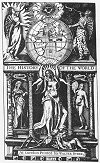
A FAMOUS CRYPTIC TITLE
PAGE.
From Selenus' Cryptomenytices et Cryptographiæ.
One year after the publication of the
first Great "Shakespearian" Folio, a remarkable volume on cryptogram,
and ciphers was published. The title page of the work is reproduced
above. The year of its publication (1624) was during the Rosicrucian
controversy. The translation of the title page is as follows:
"The Cryptomenysis and Cryptography of
Gustavus Selenus in nine books, to which is added a clear explanation of
the System of Steganography of John Trithemius, Abbot of Spanheim and
Herbipolis, a man of admirable genius. Interspersed with worthy
inventions of the Author and others, 1624." The author of this volume
was believed to be Augustus, Duke of Brunswick. The symbols and emblems
ornamenting the title page, however, are conclusive evidence that the
fine hand of the Rosicrucians was behind its publication. At the bottom
of the picture is a nobleman (Bacon?) placing his hat on another man's
head. In the oval at the top of the plate, it is possible that the
lights are beacons, or a play upon the name Bacon. In the two side
panels are striking and subtle "Shakespearian" allusions. On the left is
a nobleman (possibly Bacon) handing a paper to another man of mean
appearance who carries in his hand a spear. At the right, the man who
previously carried the spear is shown in the costume of an actor,
wearing spurs and blowing a horn. The allusion to the actor blowing his
horn and the figure carrying the spear suggest much, especially as spear
is the last syllable of the name "Shakespeare."
Secret alphabets were not
entirely satisfactory, however, for although they rendered
unintelligible the true nature of the writings, their very presence
disclosed the fact of concealed information--which the priests also
sought to conceal. Through patience or persecution, the keys to these
alphabets were eventually acquired and the contents of the documents
revealed to the unworthy. This who translated the cipher
manuscript of the friar, declared: "There are drawings which so
accurately portray the actual appearance of certain objects that it is
difficult to resist the inference that Bacon had seen them with the
microscope. * * * These are spermatozoa, the body cells and the
seminiferous tubes, the ova, with their nuclei distinctly indicated.
There are nine large drawings, of which one at least bears considerable
resemblance to a certain stage of development of a fertilized cell."
(See Review of Reviews, July, 1921.) Had Roger Bacon failed to
conceal this discovery under a complicated cipher, he would have been
persecuted as a heretic and would probably have met the fate of other
early liberal thinkers. In spite of the rapid progress made by science
in the last two hundred and fifty years, it still remains ignorant
concerning many of the original discoveries made by mediæval
investigators. The only record of these important findings is that
contained in the cryptograms of the volumes which they published. While
many authors have written on the subject of cryptography, the books most
valuable to students of philosophy and religion are: Polygraphia
and Steganographia, by Trithemius, Abbot of Spanheim; Mercury,
or The Secret and Swift Messenger, by John Wilkins, Bishop of
Chester; dipus Ægyptiacus and other works by Athanasius Kircher,
Society of Jesus; and Cryptomenytices et Cryptographiæ, by
Gustavus Selenus.
To illustrate the basic
differences in their construction and use, the various forms of ciphers
are here grouped under seven general headings:
1. The literal cipher.
The most famous of all literal cryptograms is the famous biliteral
cipher described by Sir Francis Bacon in his De Augmentis
Scientiarum. Lord Bacon originated the system while still a young
man residing in Paris. The biliteral cipher requires the use of two
styles of type, one an ordinary face and the other specially cut. The
differences between the two fonts are in many case so minute that it
requires a powerful magnifying glass to detect them. Originally, the
cipher messages were concealed only in the italicized words, sentences,
or paragraphs, because the italic letters, being more ornate than the
Roman letters, offered greater opportunity for concealing the slight but
necessary variations. Sometimes the letters vary a trifle in size; at
other times in thickness or in their ornamental flourishes. Later, Lord
Bacon is believed to have had two Roman alphabets specially prepared in
which the differences were so trivial that it is almost impossible for
experts to distinguish them.
A careful inspection of the
first four "Shakespeare" folios discloses the use throughout the volumes
of several styles of type differing in minute but distinguishable
details. It is possible that all the "Shakespeare" folios contain
ciphers running through the text. These ciphers may have been added to
the original plays, which are much longer in the folios than in the
original quartos, full scenes having been added in some
instances.
The biliteral cipher was not
confined to the writings of Bacon and "Shakespeare," however, but
appears in many books published during Lord Bacon's lifetime and for
nearly a century after his b death. In referring to the biliteral
cipher, Lord Bacon terms it omnia per omnia. The cipher may run
through an entire book and be placed therein at the time of printing
without the knowledge of the original author, for it does not
necessitate the changing of either words or punctuation. It is possible
that this cipher was inserted for political purposes into many documents
and volumes published during the seventeenth century. It is well known
that ciphers were used for the same reason as early as the Council of
Nicæa.
The Baconian biliteral cipher
is difficult to use today, owing to the present exact standardization of
type and the fact that so few books are now hand set. Accompanying this
chapter are facsimiles of Lord Bacon's biliteral alphabet as it appeared
in the 1640 English translation of De Augmentis Scientiarum.
There are four alphabets, two for the capital and two for the small
letters. Consider carefully the differences between these four and note
that each alphabet has the power of either the letter a or the
letter b, and that when reading a word its letters are divisible
into one of two groups: those which correspond to the letter a
and those which correspond to the letter b. In order to employ
the biliteral cipher, a document must contain five times as many letters
as there are in the cipher message to be concealed, for it requires five
letters to conceal one. The biliteral cipher somewhat resembles a
telegraph code in which letters are changed into dots and dashes;
according to the biliteral system, however, the dots and dashes are
represented respectively by a's and b's. The word
biliteral is derived from the fact that all letters of the
alphabet may be reduced to either a or b. An example of
biliteral writing is shown in one of the accompanying diagrams. In order
to demonstrate the working of this cipher, the message concealed within
the words "Wisdom and understanding are more to be desired than riches"
will now be deciphered.
The first step is to discover
[he letters of each alphabet and replace them by their equivalent
a or b in accordance with the key given by Lord Bacon in
his biliteral alphabet (q.v.). In the word wisdom, the W
is from the b alphabet; therefore it is replaced by a b. The
i is from the a alphabet; therefore an a is put in
its place. The s is also from the a alphabet, but the
d belongs to the b alphabet. The o and the m
both belong to the a alphabet is replaced by a. By this
process the word WISDOM become baabaa. Treating the remaining
words of the sentence in a similar manner, AND becomes aba;
UNDERSTANDING, aaabaaaaaabab; ARE, aba; MORE, abbb;
TO, ab; BE, ab; DESIRED, abaabaa; THAN,
aaba; RICHES, aaaaaa.
The next step is to run all the
letters together; thus:
baabaaabaaaabaaaaaabababaabbbabababaabaaaabaaaaaaa. All the
combinations used in the Baconian biliteral cipher consist of groups
containing five letters each. Therefore the solid line of letters must
be broken into groups of five in the following manner: baaba
aabaa aabaa aaaab ababa abbba babab aabaa aabaa aaaaa.
Each of these groups of five letters now represents one letter of the
cipher, and the actual letter can now be determined by comparing the
groups with the alphabetical table, The Key to the Biliteral Cipher,
from De Augmentis Scientiarum (q.v.): baaba = T,
aabaa = E, aabaa = E; aaaab = B; ababa = L;
abbba = P; babab = X; aabaa = E, aabaa = E;
aaaaa = A; but the last five letters of the word riches
being set off by a period from the initial r, the last five
a's do not count in the cipher. The letters thus extracted are
now brought together in order, resulting in TEEBLPXEE.
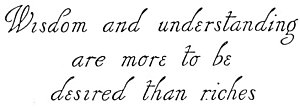
AN EXAMPLE OF BILITERAL
WRITING.
In the above sentence note
carefully the formation of the letters. Compare each letter with the two
types of letters in the biliteral alphabet table reproduced from Lord
Bacon's De Augmentis Scientiarum. A comparison of the "d" in "wisdom"
with the "d" in "and" discloses a large loop at the top of the first,
while the second shows practically no loop at all. Contrast the "i" in
"wisdom" with the "i" in "understanding." In the former, the lines are
curved and in the latter angular. A similar analysis of the two "r's" in
"desired" reveals obvious differences. The "o" in "more" differs only
from the "o" in "wisdom" in that it a tiny line continues from the top
over towards the "r." The "a" in "than" is thinner and more angular than
the "a" in "are," while the "r" in "riches" differs from that in
"desired" in that the final upright stroke terminates in a ball instead
of a sharp point. These minor differences disclose the presence of the
two alphabets employed in writing the sentence.
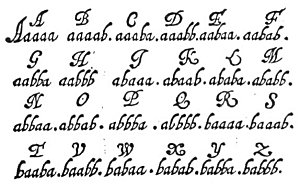
THE KEY TO THE BILITERAL
CIPHER.
From Bacon's De Augmentis
Scientiarum.
After the document to be
deciphered has been reduced to its "a" and "b" equivalents, it is then
broken up into five-letter groups and the message read with the aid of
the above table.

A MODERN WHEEL, OR DISC,
CIPHER.
The above diagram shows a wheel
cipher. The smaller, or inner, alphabet moves around so that any one of
its letters may be brought opposite any me of he letters on the larger,
or outer, alphabet. In some, cases the inner alphabet is written
backwards, but in the present example, both alphabets read the same
way.
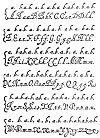
THE BILITERAL ALPHABET.
From Bacon's De Augmentis
Scientiarum.
This Plate is reproduced from
Bacon's De Augmentis Scientiarum, and shows the two alphabets as
designed by him for the purpose of his cipher. Each capital and small
letter has two distinct forms which are designated "a" and "b". The
biliteral system did not in every instance make use of two alphabets in
which the differences were as perceptible as in the example here given,
but the two alphabets were always used; sometimes variations are so
minute that it requires a powerful magnifying glass to distinguish the
difference between the "a" and "b" types of letters.
Secret alphabets were not
entirely satisfactory, however, for although they rendered
unintelligible the true nature of the writings, their very presence
disclosed the fact of concealed information--which the priests also
sought to conceal. Through patience or persecution, the keys to these
alphabets were eventually acquired and the contents of the documents
revealed to the unworthy. This is opposite the H of the outer
alphabet, so that for cipher purposes these letters are interchangeable.
The F and M, the P, and Y, the W and D, in fact all the letters, may be
transposed as shown by the two circles. The nine letters extracted by
the biliteral cipher may thus be exchanged for nine others by the wheel
cipher. The nine letters are considered as being on the inner circle of
the wheel and are exchanged for the nine letters on the outer circle
which are opposite the inner letters. By this process the T becomes A;
the two E's become two L's; the B becomes I, the L becomes S; the P
becomes W; the X becomes E; and the two E's become two L's. The result
is ALLISWELL, which, broken up into words, reads: "All is
well."
Of course, by moving the inner
disc of the wheel cipher, many different combinations in addition to the
one given above can be made of the letters, but this is the only one
which will produce sense, and the cryptogrammatist must keep on
experimenting until he discovers a logical and intelligible message. He
may then feel reasonably sure that he has deciphered the system. Lord
Bacon involved the biliteral cipher in many different ways. There are
probably a score of different systems used in the "Shakespeare" folio
alone, some so intricate that they may forever baffle all attempts at
their decipherment. In those susceptible of solution, sometimes the
a's and b's have to be exchanged; at other times the
concealed message is written backwards; again only every other letter is
counted; and so on.
There are several other forms
of the literal cipher in which letters are substituted for each other by
a prearranged sequence. The simplest form is that in which two alphabets
are written thus:
|
A |
B |
C |
D |
E |
F |
G |
H |
I |
K |
L |
M |
N |
|
Z |
Y |
X |
W |
U |
T |
S |
R |
Q |
P |
O |
N |
M |
|
|
|
|
|
|
|
|
|
|
|
|
|
|
|
O |
P |
Q |
R |
S |
T |
U |
W |
X |
Y |
Z |
|
|
|
L |
K |
I |
H |
G |
F |
E |
D |
C |
B |
A |
|
|
By substituting the letters of
the lower alphabet for their equivalents in the upper one, a meaningless
conglomeration results, the hidden message being decoded by reversing
the process. There is also a form of the literal cipher in which the
actual cryptogram is written in the body of the document, but
unimportant words are inserted between important ones according to a
prearranged order. The literal cipher also includes what are called
acrostic signatures--that is, words written down the column by the use
of the first letter of each line and also more complicated acrostics in
which the important letters are scattered through entire paragraphs or
chapters. The two accompanying alchemical cryptograms illustrate another
form of the literal cipher involving the first letter of each word.
Every cryptogram based upon the arrangement or combination of the
letters of the alphabet is called a literal cipher.
2. The pictorial cipher.
Any picture or drawing with other than its obvious meaning may be
considered a pictorial cryptogram. Instances of pictorial cipher are
frequently found in Egyptian symbolism and early religious art. The
diagrams of alchemists and Hermetic philosophers are invariably
pictorial ciphers. In addition to the simple pictorial cipher, there is
a more technical form in which words or letters are concealed by the
number of stones in a wall, by the spread of birds' wings in flight, by
ripples on the surface of water, or by the length and order of lines
used in shading. Such cryptograms are not obvious, and must be decoded
with the aid of an arbitrary measuring scale, the length of the lines
determining the letter or word concealed. The shape and proportion of a
building, the height of a tower, the number of bars in a window, the
folds of a man's garments--even the proportions or attitude of the human
body--were used to conceal definite figures or characters which could be
exchanged for letters or words by a person acquainted with the
code.
Initial letters of names were
secreted in architectural arches and spans. A notable example of this
practice is found on the title page of Montaigue's Essays, third
edition, where an initial B is formed by two arches and an F by a broken
arch. Pictorial cryptograms are sometimes accompanied by the key
necessary for their decipherment. A figure may point toward the starting
point of the cipher or carry in its hand some implement disclosing the
system of measurement used. There are also frequent instances in which
the cryptographer purposely distorted or improperly clothed some figure
in his drawing by placing the hat on backwards, the sword on the wrong
side, or the shield on the wrong arm, or by employing some similar
artifice. The much-discussed fifth finger on the Pope's hand in
Raphael's Sistine Madonna and the sixth toe on Joseph's foot in
the same artist's Marriage of the Virgin are cunningly concealed
cryptograms.
3. The acroamatic
cipher. The religious and philosophical writings of all nations abound
with acroamatic cryptograms, that is, parables and allegories. The
acroamatic is unique in that the document containing it may be
translated or reprinted without affecting the cryptogram. Parables and
allegories have been used since remote antiquity to present moral truths
in an attractive and understandable manner. The acroamatic cryptogram is
a pictorial cipher drawn in words and its symbolism must be so
interpreted. The Old and New Testaments of the Jews, the writings of
Plato and Aristotle, Homer's Odyssey and Iliad, Virgil's
Æneid, The Metamorphosis of Apuleius, and Æsop's
Fables are outstanding examples of acroamatic cryptography in
which are concealed the deepest and most sublime truths of ancient
mystical philosophy.
The acroamatic cipher is the
most subtle of all, for the parable or allegory is susceptible of
several interpretations. Bible students for centuries have been
confronted by this difficultly. They are satisfied with the moral
interpretation of the parable and forget that each parable and allegory
is capable of seven interpretations, of which the seventh--the
highest--is complete and all-inclusive, whereas the other six (and
lesser) interpretations are fragmentary, revealing but part of the
mystery. The creation myths of the world are acroamatic cryptograms, and
the deities of the various pantheons are only cryptic characters which,
if properly understood, become the constituents of a divine alphabet.
The initiated few comprehend the true nature of this alphabet, but the
uninitiated many worship the letters of it as gods.
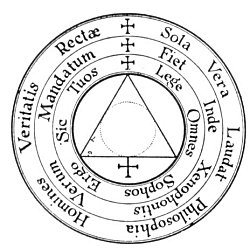
AN ALCHEMICAL
CRYPTOGRAM.
From Brown's History of
Chemistry.
James Campbell Brown reprints a
curious cipher from Kircher. The capital letters of the seven words in
the outer circle read clockwise, form the word SVLPHVR. From the words
in the second circle, when read in a similar manner, is derived FIXVM.
The capitals of the six words in the inner circle, when properly
arranged, also read ESTSOL. The following cipher is thus extracted:
"Sulphur Fixum Est Sol," which when translated is: "Fixed sulphur is
gold."
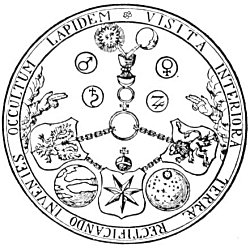
AN ALCHEMICAL
CRYPTOGRAM.
From Geheime Figuren der
Rosenkreuzer.
Beginning with the word VISITA
and reading clockwise, the seven initial letters of the seven words
inscribed in the outer circle read: VITRIOL. This is a very simple
alchemical enigma, but is a reminder that those studying works on
Hermeticism, Rosicrucianism, alchemy, and Freemasonry should always be
on the lookout for concealed meanings hidden either in Parables and
allegories or in cryptic arrangements of numbers, letters, and
words.
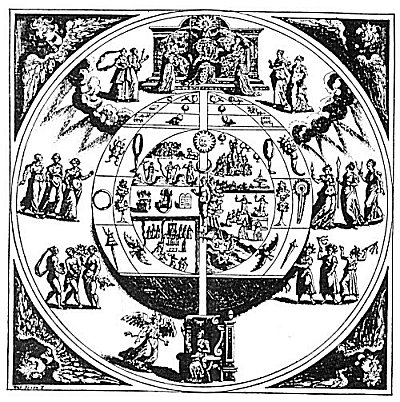
A CRYPTIC DEPICTION OF DIVINE AND NATURAL
JUSTICE.
From Selenus' Cryptomenytices et Cryptographiæ.
The first circle portrays the divine
antecedents of justice, the second the universal scope of justice, and
the third the results of human application of justice. Hence, the first
circle deals with divine principles, the second circle with mundane
affairs, and the third circle with man. On the at the top of the picture
sits Themis, the presiding spirit of law, and at her feet three other
queens--Juno, Minerva, and Venus--their robes ornamented with geometric
figures. The axis of law connects the throne, of divine justice above
with the throne of human judgment at the bottom of the picture. Upon the
latter throne is seated a queen with a scepter in her hand, before whom
stands the winged goddess Nemesis--the angel of judgment.
The second Circle is divided into
three parts by two sets of two horizontal lines. The upper and light
section is called the Supreme Region and is the abode of the gods, the
good spirits, and the heroes. The lower and dark section is the abode of
lust, sin, and ignorance. Between these two extremes is the larger
section in which are blended the powers and impulses of both the
superior and the inferior regions.
In the third or inner circle is man, a
tenfold creature, consisting of nine parts--three of spirit, three of
intellect, and three of soul--enclosed within one constitution.
According to Selenus, man's three spiritual qualities are thought,
speech, and action; his three intellectual qualities are memory,
intelligence, and will; and his three qualities of soul are
understanding, courage, and desire. The third circle is further divided
into three parts called ages: the Golden Age of spiritual truth in the
upper right section, the Iron Age of spiritual darkness in the lower
right section and the Bronze Age--a composite of the two occupying the
entire left half of the inner circle and itself divided into three
parts. The lowest division of the Bronze Age depicts ignorant man
controlled by force, the central the partly awakened man controlled by
jurisprudence, and the upper the spiritually illuminated man controlled
by love. Both the second and third circles revolve upon the axis of law,
but the divine source, of law--Heavenly Justice--is concealed by clouds.
All of the symbols and figures ornamenting the plate are devoted to a
detailed amplification of the principles here
outlined.
4. The numerical cipher.
Many cryptograms have been produced in which numbers in various
sequences are substituted for letters, words, or even complete thoughts.
The reading of numerical ciphers usually depends upon the possession of
specially arranged tables of correspondences. The numerical cryptograms
of the Old Testament are so complicated that only a few scholars versed
in rabbinical lore have ever sought to unravel their mysteries. In his
dipus Ægyptiacus, Athanasius Kircher describes several Arabian
Qabbalistic theorems, and a great part of the Pythagorean mystery was
concealed in a secret method in vogue among Greek mystics of
substituting letters for numbers.
The most simple numerical
cipher is that in which the letters of the alphabet are exchanged for
numbers in ordinary sequence. Thus A becomes 1, B 2,
C 3, and so on, counting both I and J as 9 and both
U and V as 20. The word yes by this system would be
written 23-5-18. This cipher can be made more difficult by reversing the
alphabet so that Z becomes 1, Y 2, X 3, and so on.
By inserting a non-significant, or uncounted, number after each of the
significant numbers the cipher is still more effectively concealed,
thus: 23-16-5-9-18. The word yes is found by eliminating the
second and fourth numbers. By adding 23, 5, and 18 together the sum 46
results. Therefore 46 is the numerical equivalent of the word
yes. According to the simple numerical cipher, the sum 138 is
equal to the words Note carefully. Therefore in a book using this
method, line 138, page 138, or paragraph 138 may contain the concealed
message. In addition to this simple numerical cipher there are scores of
others so complicated that no one without the key can hope to solve
them.
Authors sometimes based their
cryptograms upon the numerical value of their own names; for example,
Sir Francis Bacon repeatedly used the cryptic number 33--the numerical
equivalent of his name. Numerical ciphers often involve the pagination
of a book. Imperfect pagination, though generally attributed to
carelessness, often conceals important secrets. The mispaginations found
in the 1623 folio of "Shakespeare" and the consistent recurrence of
similar errors in various volumes printed about the same period have
occasioned considerable thought among scholars and cryptogrammatists. In
Baconian cryptograms, all page numbers ending in 89 seem to have a
special significance. The 89th page of the Comedies in the 1623
folio of "Shakespeare" shows an error of type in the pagination, the "9"
being from a considerably smaller font than the "8." The 189th page is
entirely missing, there being two pages numbered 187; and page 188 shows
the second " 8 " scarcely more than half the size of the first one. Page
289 is correctly numbered and has no unusual features, but page 89 of
the Histories is missing. Several volumes published by Bacon show
similar errors, page 89 being often involved.
There are also numerical
ciphers from which the cryptic message may be extracted by counting
every tenth word, every twentieth word, or every fiftieth word. In some
cases the count is irregular. The first important word may be found by
counting 100, the second by counting 90, the third by counting 80, and
so on until the count of 10 is reached. The count then returns to 100
and the process is repeated.
5. The musical cipher.
John Wilkins, afterwards Bishop of Chester, in 1641 circulated an
anonymous essay entitled Mercury, or the Secret and Swift
Messenger. In this little volume, which was largely derived from the
more voluminous treatises of Trithemius and Selenus, the author sets
forth a method whereby musicians can converse with each other by
substituting musical notes for the letters of the alphabet. Two persons
understanding the code could converse with each other by merely playing
certain notes upon a piano or other instrument. Musical cryptograms can
be involved to an inconceivable point; by certain systems it is possible
to take an already existing musical theme and conceal in it a cryptogram
without actually changing the composition in any way. The pennants upon
the notes may conceal the cipher, or the actual sounds of the notes may
be exchanged for syllables of similar sound. This latter method is
effective but its scope is somewhat limited. Several musical
compositions by Sir Francis Bacon are still in existence. An examination
of them might reveal musical cryptograms, for it is quite certain that
Lord Bacon was well acquainted with the manner of their
construction.
6. The arbitrary cipher.
The system of exchanging letters of the alphabet for hieroglyphic
figures is too easily decoded to be popular. Albert: Pike describes an
arbitrary cipher based upon the various parts of the Knights Templars'
cross, each angle representing a letter. The many curious alphabets that
have been devised are rendered worthless, however, by the table of
recurrence. According to Edgar Allan Poe, a great cryptogrammatist, the
most common letter of the English language is E, the other letters in
their order of frequency are as follows: A, O, I, D, H, N, R, S, T,
V, Y, C, F, Q L, M, W, B, K, P, Q, X, Z. Other authorities declare
the table of frequency to be: E, T, A, O, N, I, R, S, H, D, L, C, W,
U, M, F, Y, G, P, B, V, K, X, Q, J, Z. By merely counting the number
of times each character appears in the message, the law of recurrence
discloses the English letter for which the arbitrary character stands.
Further help is also rendered by the fact that if the cryptogram be
split up into words there are only three single letters which may form
words: A, I, O. Thus any single character set off from the rest
of the text must be one of these three letters. For details of this
System see The Gold Bug, by Edgar Allan Poe.
To render more difficult the
decoding of arbitrary ciphers, however, the characters are seldom broken
up into words, and, further, the table of recurrence is partly nullified
by assigning two or more different characters to each letter, thereby
making it impossible to estimate accurately the frequency of recurrence.
Therefore, the greater the number of arbitrary characters used to
represent any single letter of the alphabet, the more difficult it is to
decipher an arbitrary cryptogram. The secret alphabets of the ancients
are comparatively easy to decode, the only requisites being a table of
frequency, a knowledge of the language in which the cryptogram was
originally written, a moderate amount of patience, and a little
ingenuity.
7. The code cipher. The
most modem form of cryptogram is the code system. Its most familiar form
is the Morse code for use in telegraphic and wireless communication.
This form of cipher may be complicated somewhat by embodying dots and
dashes into a document in which periods and colons are dots, while
commas and semicolons are dashes. There are also codes used by the
business world which can be solved only by the use of a private code
book. Because they furnish an economical and efficient method of
transmitting confidential information, the use of such codes is far more
prevalent than the average person has any suspicion.
In addition to the foregoing
classifications there are a number of miscellaneous systems of secret
writing, some employing mechanical devices, others colors. A few make
use of sundry miscellaneous objects to represent words and even complete
thoughts. But as these more elaborate devices were seldom employed by
the ancients or by the mediæval philosophers and alchemists, they have
no direct bearing upon religion and philosophy. The mystics of the
Middle Ages, borrowing the terminology of the various arts and sciences,
evolved a system of cryptography which concealed the secrets of the
human soul under terms generally applied to chemistry, biology,
astronomy, botany, and physiology. Ciphers of this nature can only be
decoded by individuals versed in the deep philosophic principles upon
which these mediæval mystics based their theories of life. Much
information relating to the invisible nature of man is concealed under
what seem to be chemical experiments or scientific speculations. Every
student of symbolism and philosophy, therefore, should be reasonably
well acquainted with the underlying principles of cryptography; in
addition to serving him well in his researches, this art furnishes a
fascinating method of developing the acuteness of the mental faculties.
Discrimination and observation are indispensable to the seeker after
knowledge, and no study is equal to cryptography as a means of
stimulating these powers.
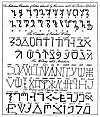
QABBALISTIC AND MAGIC
ALPHABETS.
From Barrett's Magus.
Curious alphabets were invented by the
early and mediæval philosophers to conceal their doctrines and tenets
from the profane. Some of these alphabets are still used to a limited
extent in the higher degrees of Freemasonry. Probably the most famous is
the angelic writing, termed in the above plate "The Writing called
Malachim." Its figures are supposedly derived from the constellations.
Advanced students of occult philosophy will come upon many valuable
documents in which these figures are used. Under each letter of the
first alphabet above is its equivalent in English. Above each letter of
the other three alphabets is its Hebrew letter equivalent.
back to top |
![]()














